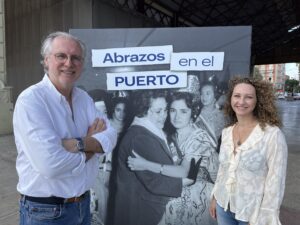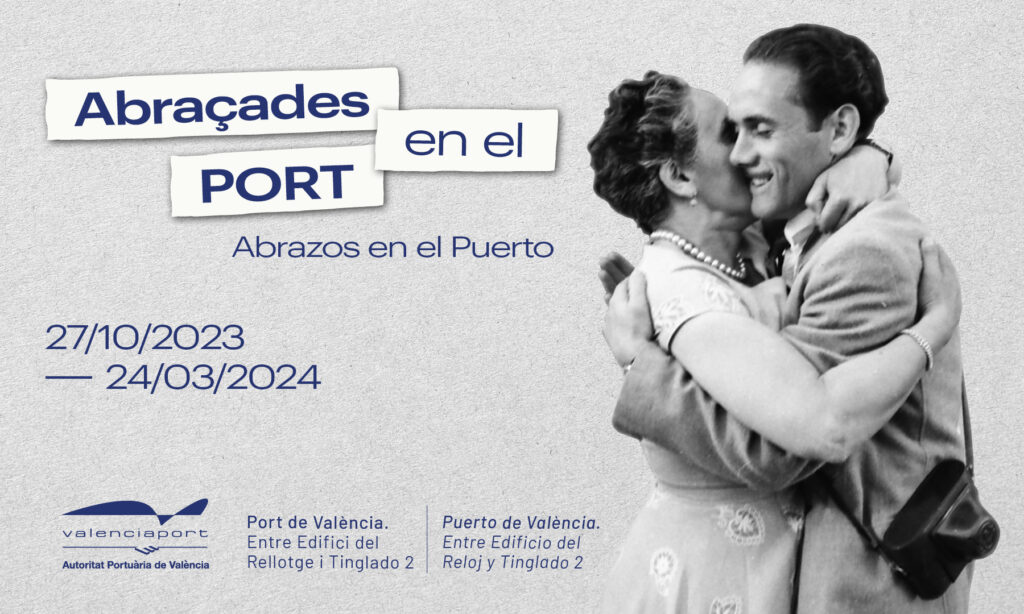
- Farewells and reunions of Valencian families in three moments of the 20th century are immortalised in ‘Abraçades en el port’, an ‘open-air’ photographic exhibition located along Tinglado number 2, next to the Clock Building
- The exhibition, organised by the Port Authority of Valencia and curated by the art historian Ester Medán, is made up of images that have been donated by the family of the photographer Luis Vidal Ayala
València, 2 November 2023.- Tears of farewell and reunion, smiles, displays of affection, caresses… and hugs, lots of hugs. This everyday gesture has become the undisputed protagonist of the exhibition ‘Abraçades en el port’, an exhibition that captures farewells and reunions in three historic moments of the 20th century that marked a before and after for hundreds of Valencian families.
‘Abraçades en el port’ is an ‘open-air’ exhibition located between the iconic Clock Building and Tinglado number 2 and is made up of seven totem poles dressed up with around 40 photographs featuring the embraces of Valencian neighbours at moments charged with emotion. The exhibition highlights the Port of València as the setting for dates marked in the calendar as “historic” but which also have an important “collective” significance for the inhabitants of the Comunitat.

The exhibition has been organised by the Port Authority of València (PAV) and curated by the art historian Ester Medán, while the images have been donated by the family of Luis Vidal Ayala, a Valencian photographer who has also collaborated closely in the choice of the historic moments that are the protagonists of the exhibition and in the selection of the final snapshots that will be on display until 24 March on the seven totem poles.
Familiar and historic moments
As Medán pointed out during the presentation, “this exhibition is a unique opportunity for people strolling through the Port of València to get to know these historic events that have taken place here and which have been very important moments for Valencians and also significant collectively and individually”.
In this sense, Medán emphasised that “the common thread of the exhibition is the emotionally charged embraces of farewells or reunions, at a historical moment in which communication between people is not like it is now, when we are permanently connected. Before, when they said goodbye, they didn’t know when they would be able to see or speak to each other again, and this is reflected in the photographs. Now it is much simpler.
For photographer Luis Vidal, this exhibition is of great historical importance because it immortalises the experience of thousands of entire families from a human point of view. “In the case of the Valencian farmers who left for the Dominican Republic, you can see the illusion and happiness on their faces, even though they don’t know when they will return. It is incredible how the Valencian entrepreneurial spirit is reflected in the selected snapshots”. Regarding the selection of the images for the exhibition, Vidal assures that “a lot of work has been done to choose the photographs that best reflect the collective stories through individual but meaningful looks”.
Three historical moments from a human point of view
The exhibition allows us to learn about personal stories through historical photographs of three unique moments. The first of these, entitled ‘From València to the Dominican Republic’, shows snapshots of a story of farewells, that of more than 5,000 Valencian farmers – sometimes entire families – who migrated to the Dominican Republic in the hope of a more prosperous life. On 15 May 1955, thousands of farm workers with their wives and children left the Valencian docks loaded with dreams for a life that promised to be better in the Dominican Republic.
The mission of these Valencians was to collaborate in the rural repopulation and agricultural development of this country. In exchange for their work, they were promised housing, land and the necessary resources to begin their work. Once there, the reality became clear: unhealthy housing, isolated from each other and in the middle of an unspoilt natural environment with poor communications, conditions that had nothing to do with the promises made. They soon set off on their return, deeply disappointed.
The second of these is the ‘Return of the ‘Children of Russia’: In 1956, the ship Crimea arrived at the Port of Valencia with more than 500 repatriated Spaniards on board. The return of children exiled in Russia during the Spanish Civil War took place almost twenty years after their departure. They took the longest time to return to Spain because World War II caught them in a very hot zone of the conflict. During that year, 500 of the so-called “Children of Russia” arrived at the Port of València, now adults. And the third one, ‘Falleros ships’: Between 1961 and 1972 thousands of Valencian emigrants in Latin America travelled to València to enjoy the Fallas in the so-called “Barcos Falleros”. In this period up to twelve “Falleros ships” arrived at the Port of València with Valencian emigrants (to Chile, Argentina, Uruguay and Brazil) and their descendants living in Latin America to visit València during the Fallas festivities. The photographs show the arrival of several of these ships that filled the Port of València with the excitement and joy of a crowd celebrating the reunion, united by one of the most representative cultural manifestations of the Valencian Community: Las Fallas.

